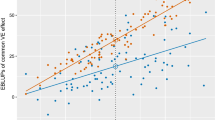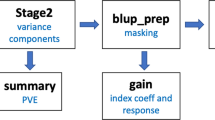Abstract
Multilocation trials in plant breeding lead to cross-classified data sets with rows=genotypes and columns=environments, where the breeder is particularly interested in the rank orders of the genotypes in the different environments. Non-identical rank orders are the result of genotype x environment interactions. Not every interaction, however, causes rank changes among the genotypes (rank-interaction). From a breeder's point of view, interaction is tolerable only as long as it does not affect the rank orders. Therefore, the question arises of under which circumstances does interaction become rank-interaction. This paper contributes to our understanding of this topic. In our study we emphasized the detection of relationships between the similarity of the rank orders (measured by Kendall's coefficient of concordance W) and the functions of the diverse variance components (genotypes, environments, interaction, error). On the basis of extensive data sets on different agricultural crops (faba bean, fodder beet, sugar beet, oats, winter rape) obtained from registration trials (1985–1989) carried out in the Federal Republic of Germany, we obtained the following as main result: W ≅ σ g2 /(σ g2 + σ v2 ) where σ g2 =genotypic variance and σ v2 = σ ge2 + σ o2 /L with σ ge2 =interaction variance, σ o2 =error variance and L=number of replications.
Similar content being viewed by others
References
Azzalini A, Cox DR (1984) Two new tests associated with analysis of variance. J R Stat Soc B 46:335–343
Baker RJ (1988) Tests for crossover genotype-environmental interactions. Can J Plant Sci 68:405–410
Berger RL (1984) Testing for the same ordering in several groups of means. In: Santner TJ, Tamhane AC Design of experiments. Ranking and selection. Marcel Dekker, New York, pp 241–249
Comstock RE (1977) Quantitative genetics and the design of breeding programs. In: Pollak E, Kempthorne O, Bailey TB (eds) Proc Int Conf Quant Genet. The Iowa State University Press, Ames, Iowa, pp 705–718
Gail M, Simon R (1985) Testing for qualitative interactions between treatment effects and patient subsets. Biometrics 41:361–372
Gibbons JD (1985) Nonparametric statistical inference, 2nd edn. (Statistics: textbooks and monographs 65). Marcel Dekker, New York, Basel
Kendall MG (1962) Rank correlation methods, 3rd edn. Griffin, London
Kroon J, de Laan P van der (1981) Distribution-free test procedures in two-way layouts; a concept of rank-interaction. Stat Neerl 35:189–213
Laan P van der (1987) Extensive tables with exact critical values of a distribution-free test for rank-interaction in a two-way layout. Biuletyn Oceny Odmian 12:195–202
Virk DS, Mangat BK (1991) Detection of cross over genotype x environment interactions in pearl millet. Euphytica 52:193–199
Zelterman D (1990) On tests for qualitative interactions. Stat Prob Lett 10:59–63
Author information
Authors and Affiliations
Additional information
Communicated by P. M. A Tigerstedt
Rights and permissions
About this article
Cite this article
Hühn, M., Lotito, S. & Piepho, H.P. Relationships between genotype x environment interactions and rank orders for a set of genotypes tested in different environments. Theoret. Appl. Genetics 86, 943–950 (1993). https://doi.org/10.1007/BF00211045
Received:
Accepted:
Issue Date:
DOI: https://doi.org/10.1007/BF00211045




